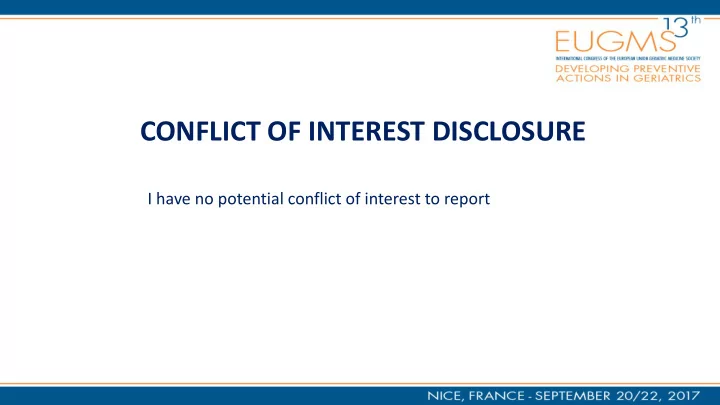

CONFLICT OF INTEREST DISCLOSURE I have no potential conflict of interest to report
mechanistic actions for potential neuroprotective effect of polyphenols certainly not by a direct antioxidant effect as ROS scavengers !!!!! absorption, relatively poor bioavailability, numerous metabolites with unknown biological activities 70 µM 60 50 40 low concentration 30 in plasma, 20 urine and cells 10 0 vitamine C vitamine E polyphénols
Challenges for research on polyphenols from foods in Alzheimer’s disease : bioavailability, metabolism and cellular and molecular mechanisms. (Singh et al. J Agric Food Chem, 2008) absorption and bioavailability ability to cross the blood – brain barrier ? Polyphenols beyond barrier s : a glimpse into the brain. (Figueira et al. Curr Neuropharmacol, 2017)
C. Elegans model of AD not able to cross the BBB able to cross the BBB not able to cross the BBB
potential neuroprotective action of berries polyphenols : why does it work ? the biological activity of polyphenols is linked to a moderate pro – oxidant effect and not to direct antioxidant activity (auto - oxidation of phenol groups leading to moderate ROS production)
potential neuroprotective action of berries polyphenols : why does it work ? 1) hormetic effect* activation of Keap1/NrF2/Antioxidant Response Element (ARE) leading to the expression of genes coding for antioxidant and protective enzymes • adaptation of cells to small amount of toxic products including ROS (mithridatisation effect ) Birringer M. Hormetics : dietary triggers of an adaptative stress response. Pharm Res. 2011.
Modulation of Nrf2/ARE Pathway by Food Polyphenols : A Nutritional Neuroprotective Strategy for Cognitive and Neurodegenerative Disorders (Scapagnini et al. Mol Neurobiol 44:192 – 201, 2011)
potential neuroprotective action of berries polyphenols : why does it work ? 1) hormetic effect activation of Keap1/NrF2/Antioxidant Response Element leading to expression of genes coding for antioxidant and protective enzymes 2) redox signalling (primordial importance)
2) redox signalling control moderate production of ROS
Berry fruits enhances beneficial signaling in the brain (Miller and Shukitt-Hale, J Agri Food Chem 2012) strawberry Concord grape blueberry These performance improvements were associated with attenuated levels of a variety of signaling molecules involved in stress, survival, and neural plasticity in the hippocampus, including increased levels of phosphorylated CREB, ERK1/2, protein kinase B, and MAPK- activated protein kinase 1b as well as increased levels of brain- derived neurotrophic factor (BDNF), proBDNF, and activity- regulated cytoskeleton associated protein relative to age-matched controls that showed decreased signaling.
potential neuroprotective action of berries polyphenols : why does it work ? the biological activity of polyphenols is linked to a moderate pro – oxidant effect (autooxidation of phenol groups leading to ROS production) 1) hormetic effect 2) redox signalling 3) improvement of endothelial function
3) Impaired neurovascular coupling in aging and Alzheimer's disease: Contribution of astrocyte dysfunction and endothelial impairment to cognitive decline (Tarantini et al. Experimental Gerontology 2017) endothelium dysfunction increases blood-brain barrier (BBB) permeability Vascular dysfunction in the pathogenesis of Alzheimer's disease — A review of endothelium-mediated mechanisms and ensuing vicious circles (YuriDiMarco et al. Neurobiology of Disease 2015)
the regulation of arterial blood pressure by polyphenols through adequate endothelial function eNOS BH 4 deficiency, pr é sence smoking, ’ d arginine et de BH 4 0 hypercholesterolemia 2 functional non fonctional eNOS e-NOS NO ROS (nitric oxide) production normal blood pressure through hypertension vasorelaxation activity of NO
PMCID: PMC3146307 Midlife vascular risk factor exposure accelerates structural brain aging and cognitive decline S. Debette , MD, PhD, S. Seshadri, MD, A. Beiser, PhD, R. Au, PhD, J.J. Himali, MS, C. Palumbo, PhD, P.A. Wolf, Vascular risk factor exposure accelerates structural brain aging and cognitive decline. (Debette et al. Neurology. 2011)
the regulation of arterial blood pressure by polyphenols through adequate endothelial function eNOS BH 4 deficiency, pr é sence smoking, ’ d arginine et de BH 4 0 hypercholesterolemia 2 functional non fonctional auto - oxidation eNOS e-NOS of polyphenols NO ROS (nitric oxide) production normal blood pressure hypertension Dietary polyphenols regulate endothelial function and prevent cardiovascular disease. (Yamagata K et al, Nutrition. 2015)
conclusions 1° oxidative stress (alteration in redox balance) has been well identified in human cognitive decline 2° epidemiological studies suggest that food rich in antioxidants but not classical synthetic antioxidants (vitamins C and E, carotenoids) supplementation may prevent human cognitive decline 3° promising role of dietary polyphenols (as food or extracts) in preventive human cognitive decline 4° biological activity of polyphenols through metabolites but also moderate pro – oxidant activities (hormesis, redox signalling and endothelial function)
Recommend
More recommend